Sandwiched between spending time on Symi I hopped a little further north in the Dodecanese to spend a couple of weeks on Nisyros. Google it and you will see lots of photos of ‘The Volcano’ and the Paleocastro, both very dramatic. But there is far more to the island than that. I have visited many times, in recent years spending a month each trip, each time amazed at how much I hadn’t previously seen. This year was no exception.
First off, Nisyros doesn’t ‘have a volcano’, it is a volcano. And it’s still active. To be more accurate it is a volcano which is the remnant of a much larger volcano which originally encompassed the western part of Kos, the sea in between once the caldera.
Most people get on the ‘Volcano Bus’ or hire a scooter or a car and zoom around the roads ….. and miss a great deal. Trek around on foot and the island has a wealth of natural and historical interest. The following is just a brief scratch below the surface, the island from a different perspective.

Looking down to the main crater from the caldera rim near Nikia. Sit here, sip your ouzo and wait for it to blow.

Part of the cliffed wall of the main crater from the path around the rim high above

One of the active areas away from the main crater looking across to Oros Divatis, highest point on the island. The fumarole changes all the time as the sulphur gas crystallises and is then washed away in winter rains
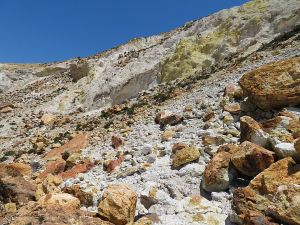
Sulphur washes down the cliffs

….. in places more thickly deposited than others. Note the caldera-rim village of Nikia high above.
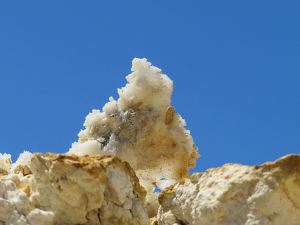
From the macro to the micro, a crystal flake on top of a pillar

In 2003 seismic activity opened a fissure in the floor of the caldera, in places 20 feet deep and more than that wide.
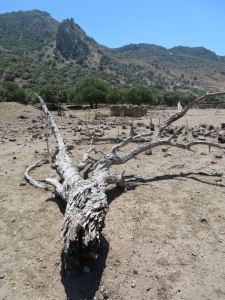
Increasingly the caldera is so hot and arid that many trees cannot survive the drought, especially closer to the main crater. This one points towards the dramatic lava cone with the Crusader fortification of Parletia on top.

Though wooded at the eastern end of the caldera, the western end towards the still-active craters is desert, though even here a few trees still survive.
The whole island is made up of rocks which are without exception volcanic in origin. Apparently, the magma chamber below the island is comparatively shallow and though there is no sign of lava flowing now, in many places past extrusions are very evident.

Some of the most dramatic, and least seen, are the lava stacks near the southeast of the island. Isolated and inaccessible, difficult to reach overland
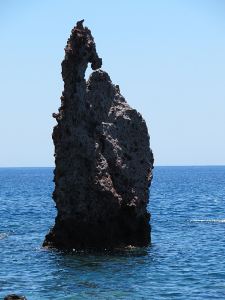
A giant sea horse emerged from the sea and has stood resolute over the centuries

On the approach to the coast at this point, gas bursting from large blocks of lava make them look as if they came from space rather than exploding out of the ground

Other blocks have contorted multicoloured patterning

While further north along the same coast pieces of lava bubble litter the shoreline (the toes give scale)

… many variations

Some are very different, looking like huge golden nuggets

Sea cliffs are very varied, in places layers of different colours and textures.
The fact that Niyros has been volcanically active over many centuries has not deterred settlement, if anything it has encouraged it because of the fertile volcanic soil. The main caldera, a number of smaller, hidden ones, and steeply terraced mountainsides were farmed and extensively populated. There are large numbers of individual houses, others in small clusters, many under the terraced fields to maximise productive area. Most are now abandoned, a few still used for agricultural purposes. Of the four main settlements, Mandraki and Palloi are on the coast, Emborios and Nikia on the rim of the main caldera.
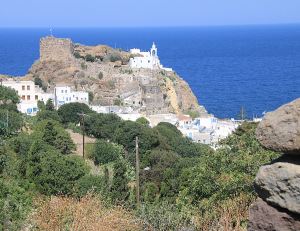
From the flank of the mountain, zooming in on the Crusader castle and the Panagia Spiliani monastery towering over Mandraki

Approaching Emborios perched on the eastern end of the caldera rim

Within the village, arches brace the buildings against seismic activity. Many are long derelict but an increasing number are now being restored, in many cases by incomers to Greece.

Perched on the southern rim of the caldera, Nikia has a very photogenic main square at the top of the village

One of the many architectural details in the square.
The island has been occupied from prehistoric times probably by a pre-Hellenic Cretan civilisation. One of the earliest settlements is thought to be Nyfios in a small high-level ‘valley’, really a dormant caldera. It was clearly settled and farmed but may also had a religious role, the ‘Sanctuary of the Nymphs’. Though ‘Nyfios’ on the maps, local people still call it ‘Nymfios’.
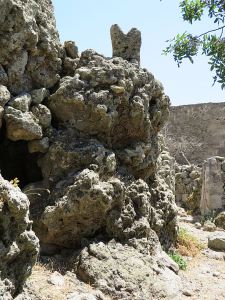
Entering the tiny, completely hidden, settlement of Nifios high in the mountains. The ‘Horns of Consecration’ carved out of the rock indicate a Minoan culture.

The main settlement is built into the rock, a single cluster of about eight houses around what is now a church which is still painted, cleaned and candles lit.

Looking from the crag across the top of the buildings along the ‘valley’, Oros Diavatis towering above

Two of the houses in the cluster. Note the massive stone lintels above the doorways.
There are also small fortified monastery complexes, most noticeably Armas and Siones. Both probably started as cave dwellings with other buildings added later including small churches. Both churches are covered in frescoes, that at Siones is open but the one at Armas is locked.

Terracotta storage containers in one of the caves below the Armas compound

Part of the fresco-covered interior of the church at Siones

Looking back at one of the two caldera leading from Siones, traversed by a now tortuous but once walled and paved footpath

One of the many small settlements on the caldera rim below Nikia, remains of a windmill above
These are some of the ‘themes’ on Nisyros but there is much else besides.

At the side of an ancient sunken pathway between terraced walls, an ancient oak has grown around a boulder next to a stepped entrance to a building and enclosure with a piece of imported dressed stone incorporated into the wall.

Scarce Swallowtails (Iphiclides podalirius) flit everywhere, occasionally settling long enough to photograph

A grass snake (Natrix natrix persa) basks in a patch of sun at the bottom of a dry sterna, next to the shadow of my head. The following day another, about 2 feet long, shot between my sandalled feet as I walked up a narrow rocky path below Emborios.

In July the spectacular flowers of capers are much in evidence

Selfie. Reflection in the water at the bottom of a sterna
Nisyros has some of the most dramatic and historically interesting landscapes I know. This year I spent two and a half weeks on the island, trekking in the mountains every day under cloudless sky in temperatures up to the mid 40s. Hard going, especially the trek to the lava stacks at the southwest of the island but worth every drop of sweat. And in the evening, with another route achieved, sit back with a beer and watch the sun go down.

In the middle of summer the sun sets into the western end of Kos
Sadly I had returned to Symi by the time of the earthquake on 21 July. At 6.7 on the Richter scale and aftershocks of 5.4 it woke me up at 01.30 with the house shaking and rattling. With the epicentre further north the impact on Nisyros must have been greater. It would have been fascinating to visit the caldera and the craters again to see what changes there had been. Next time.

Pingback: NISYROS of the Twelve Islands (Greece) |
Not sure I understand ……… ?